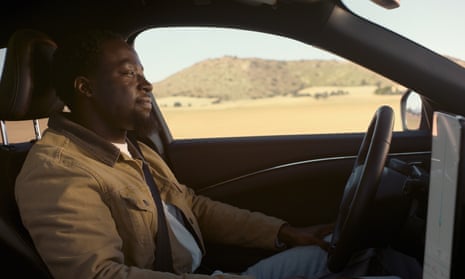
First hands-free self-driving system approved for British motorways
System in Ford’s Mustang Mach-E allows motorist to remove grip from wheel but eyes must be kept on road
Drivers will be legally allowed to take their hands off the steering wheel on Britain’s motorways for the first time as long as they watch the road, after the government approved another step on the path to self-driving cars.
The driving-assist feature in Ford’s latest Mustang Mach-E model, which allows the vehicle to steer and accelerate but also monitors the driver’s attention to ensure their eyes are on the road, will be permitted by the Department for Transport in a first for Europe.
The BlueCruise system, an £18-a-month subscription add-on to the £50,000 electric car, uses radars and cameras to track road markings and other vehicles, and an infrared camera in the car to ensure the driver’s eyes remain on the road ahead.
It will be usable on a geofenced area of 2,300 miles of motorway in England, Scotland and Wales.
Ford said the technology, which is already in use in the US and similar to Tesla’s “self-driving” features, is the first time level 2 autonomy will be available for general use on UK roads outside trials. Level 2 is defined as partial automation – the next step towards level 5, or full self-driving vehicles, on the car industry’s internationally recognised autonomy scale.
Under BlueCruise, the car can automatically brake, accelerate and reposition in a lane but will sound a warning and slow down if it detects the driver is not paying attention to the road, or if it leaves the motorway.
However, it remains a driver-assist feature, similar to many others in use such as lane-keeping and cruise control, and Ford warned it does not replace the driver’s attention, judgment and need to control the vehicle.
Britain has been vying to lead the field in autonomous driving by overhauling regulations and the transport minister Jesse Norman described the announcement as “great news”. He added: “I am delighted that this country is once more at the forefront of innovation.
“The latest advanced driver-assistance systems make driving smoother and easier but they can also make roads safer by reducing scope for driver error.”
Lisa Brankin, Ford’s managing director for the UK and Ireland, said it was “a significant moment for our industry”.
after newsletter promotion
Ford said the system had been tested on more than 100,000 miles of European roads including drives in Britain to test its mettle against worn-out lane markings, poor weather and roadworks. The poor state of UK roads was underlined on Friday by news from the AA that it had attended 10,000 more pothole-related breakdowns last month than in March 2022.
Jim Holder, the editorial director of Autocar, said the BlueCruise announcement was “another step on the road to autonomy, although the language Ford is using is a lot more cautious than Tesla’s”.
He added: “It’s a good test of how much Britain’s drivers want this technology and are willing to pay for it. A lot of research shows people are pretty suspicious, and there’s a long journey to persuade people that they want it – and to pay a monthly fee to unlock benefits on top of the £50k they’ve already paid for a car.”